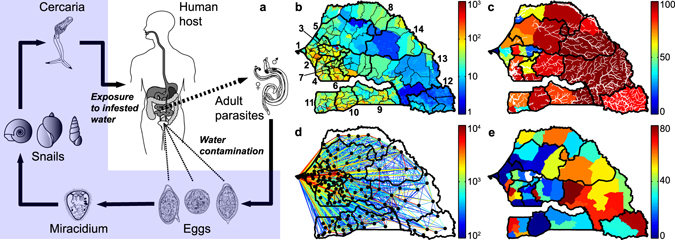Figure 1.

Schistosomiasis transmission cycle (a) and data for model application (b–e). (a) Paired adult worms within human hosts produce eggs (left to right: S. mansoni, S. japonicum, S. haematobium) that are shed through feces or urine and hatch into miracidia. Miracidia infect species-specific intermediate snail hosts (left to right: genus Biomphalaria, Bulinus, Oncomelania), which then shed free-swimming cercariae that can penetrate human skin and eventually develop into reproductive schistosomes. (b) High-resolution population density map of Senegal [inhabitants km−2]. Black lines indicate administrative boundaries (thick/thin lines are for regions/arrondissements). Regions are numbered as follows: 1–Dakar, 2–Thiès, 3–Diourbel, 4–Fatick, 5–Louga, 6–Kaolack, 7–Kaffrine, 8–Saint-Louis, 9–Kolda, 10–Sédhiou, 11–Ziguinchor, 12–Kédougou, 13–Tambacounda, 14–Matam. (c) People living in rural settings [%] (colors) and rivers of Senegal (thick/thin white lines are for perennial/ephemeral rivers). (d) Human mobility fluxes in year 2013 [number of people] estimated from anonymous mobile phone traces; the flux between any two arrondissements (say i and j, ) is obtained as K i Q ij (see Table 1). Only fluxes ≥100 people are displayed as links between arrondissement-level population centroids. (e) Prevalence of urogenital schistosomiasis [% of infected people] according to the national surveys operated by the Senegalese Ministry of Health. Data are shown at the scale of health districts and cover the timespan 1996–2013. See SI for details on data sources. The drawings in panel a are from the Centers for Disease Control and Prevention (CDC, Parasites: Schistosomiasis, http://www.cdc.gov/parasites/schistosomiasis/biology.html; last date of access: 03/02/2017). The maps in panels b–e have been created with QGIS 2.4 (QGIS Development Team, QGIS: A free and open source geographic information system, http://www.qgis.org/; last date of access: 03/02/2017) and MATLAB R2015b (MathWorks, MATLAB, http://www.mathworks.com/products/matlab/; last date of access: 03/02/2017).
